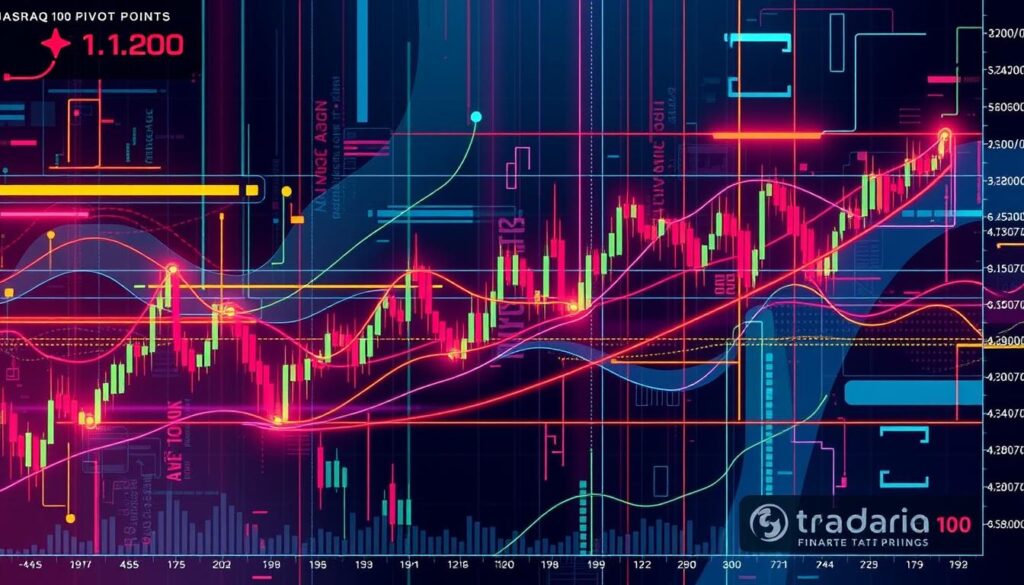Did you know the “magnificent 7” companies make up about 35% of the S&P 500? This shows how vital it is to understand the NASDAQ 100 index. It’s a key indicator for the market, offering insights for traders and investors.
In this article, we’ll explore the NASDAQ 100’s technical analysis. We’ll look at its structure, key indicators, and current trends. Knowing these details helps you make smart trading decisions in the fast-changing financial world.
Key Takeaways
- The NASDAQ 100 index is a critical barometer for the tech sector and broader market trends.
- Technical analysis of the NASDAQ 100 can provide valuable insights into support levels, resistance zones, and potential trading opportunities.
- Understanding the index’s components, market capitalization weightings, and calculation methodology is crucial for interpreting technical signals.
- Analyzing moving averages, oscillators, price action patterns, and volume data can help identify market momentum and potential turning points.
- Combining technical and fundamental analysis can enhance the accuracy and reliability of trading decisions in the NASDAQ 100 market.
Understanding the NASDAQ 100 Index Structure
The NASDAQ 100 index shows the health of the US stock market. It includes the biggest non-financial companies on the NASDAQ. It covers many sectors, like tech and healthcare, showing the market’s overall trends.
Components and Market Cap Weightings
As of June 20, 2025, the NASDAQ 100 index has 107 stocks from 100 companies. The tech sector is a big part, making up 62.25% of the index. The top 10 companies, like Apple and Microsoft, have over 48% of the index’s weight.
Historical Performance Metrics
The NASDAQ 100 index has seen ups and downs over the years. In 2023, Nasdaq rebalanced the index to fix the weight of top companies. This was the third time, showing the need to keep the index up to date.
Index Calculation Methodology
The NASDAQ 100 index uses a special way to calculate its value. It looks at the market value of each stock. This method shows how well the biggest non-financial companies are doing, giving investors a full picture.
Key Technical Indicators for Market Analysis
Understanding the NASDAQ 100 market is complex. Technical indicators are key tools for this. They help see market trends, momentum, and where to trade. Indicators like the Relative Strength Index (RSI) and Moving Average Convergence Divergence (MACD) are crucial.
The RSI shows if a market is overbought or oversold. It looks at recent gains and losses. When RSI is over 70, it might be overbought. Below 30 means it’s oversold.
Moving averages, like the Simple Moving Average (SMA) and Exponential Moving Average (EMA), are also important. They help spot market trends. When the short-term moving average goes above the long-term, it’s bullish. Going below is bearish.
Using these technical indicators and chart patterns helps traders understand the NASDAQ 100. This knowledge lets them make smart choices and find new trading chances.
Moving Average Analysis and Support Levels
In the world of technical analysis for the NASDAQ 100 index, moving averages are key. They help spot market trends and support levels. Traders use Simple Moving Averages (SMAs) and Exponential Moving Averages (EMAs) to understand the market direction.
Simple Moving Averages (SMA)
The SMA is a common tool that shows the average price over time. It gives a clear trend view. Our study of the NASDAQ 100 reveals a bullish trend. The 50-day, 100-day, and 200-day SMAs suggest support levels for the index.
Exponential Moving Averages (EMA)
The EMA focuses on recent data, making it quick to react to market changes. Our EMA analysis for the NASDAQ 100 shows both bullish and neutral signs. This highlights the importance of diverse trading strategies for traders.
Volume Weighted Moving Averages (VWMA)
The VWMA uses trading volume data for a more precise trend view. The NASDAQ 100’s VWMA (20) currently signals a neutral phase. This suggests a market consolidation period.
NASDAQ 100 Technical Analysis: Current Market Patterns
The nasdaq 100 technical analysis shows a neutral market pattern. Oscillators and moving averages are balanced, indicating no strong direction in the market trends. The NASDAQ 100 index is near key pivot points, showing possible support and resistance areas.
Traders should watch for any breakouts or breakdowns from these levels. These could signal new trends. The technical picture shows a market in balance, with investors waiting for clear moves.
By analyzing the nasdaq 100 technical analysis and market patterns, traders can spot opportunities. They can make informed decisions in the NASDAQ 100 market. Being vigilant and adaptable is crucial in this dynamic index.
Oscillator Indicators and Market Momentum
Oscillator indicators are key in understanding the NASDAQ 100 market’s momentum and when trends might change. The Relative Strength Index (RSI), Moving Average Convergence Divergence (MACD), and Stochastic Oscillator are top choices. These tools show when the market might be too high or too low.
Relative Strength Index (RSI) Signals
The RSI compares the average gain to the average loss over 14 days. If the RSI goes over 70, it means the market might be too high, a good time to sell. When it drops below 30, it’s a sign the market might be too low, a good time to buy.
MACD Analysis and Crossovers
The MACD looks at the relationship between two moving averages of the NASDAQ 100’s price. It gives signals for buying or selling based on when the MACD and signal lines cross over. Traders watch these crossovers to spot changes in trends and make smart trading choices.
Stochastic Oscillator Patterns
The Stochastic Oscillator tracks the NASDAQ 100’s price movement momentum. It signals overbought conditions when it goes over 80% and oversold when it drops below 20%. Traders use these patterns to back up signals from other indicators.
Oscillator indicators give a clear view of the NASDAQ 100’s market momentum. They help traders spot when the market is too high or too low and when trends might flip. By using these indicators in their strategies, investors can make better choices in the NASDAQ 100 market.
Price Action and Chart Patterns
Technical analysis of the NASDAQ 100 index focuses on price action and chart patterns. The current prices and recent movements help spot support and resistance zones. Traders watch for classic patterns like triangles and head and shoulders to guess future prices.
Candlestick patterns, such as the Harami cross and three white soldiers, show price action visually. This data helps in making technical indicators. More and more, institutions use algorithms to analyze past prices and trade automatically.
Understanding price action can vary among traders. This makes predictions based on past prices uncertain. To make high-probability trades, tools are used to confirm predictions. Price action doesn’t consider big economic or non-financial factors.
Many traders use candlestick charts to track price action and find breakout and reversal chart patterns. The NASDAQ 100’s high trading volume helps scalpers make quick profits from small price changes.
Volume Analysis and Trading Activity
Volume is key in stock market analysis and trading. The NASDAQ 100 index shows how much the market is involved. It tells us if price changes are strong or just temporary.
Volume Trends and Market Participation
The NASDAQ 100 index includes shares of 100 big companies. QQQQ tracks this index and is very traded. Looking at the NASDAQ 100 chart can show big insights. For example, on November 27 and 28, big volume spikes showed market activity and possible changes in mood.
On-Balance Volume (OBV) Analysis
The On-Balance Volume (OBV) indicator is important for volume analysis. It shows if trends are strong by comparing volume to price changes. If prices go up and OBV goes up too, it means buying is strong. If prices fall and OBV falls, selling is strong.
Traders should watch for volume spikes or OBV divergences. These can signal big market changes.
Using volume analysis in stock market analysis and trading strategies helps investors understand the market better. Volume data helps spot real trends from short-term changes.
Fibonacci Retracement Levels
In the world of technical analysis, Fibonacci retracement levels are key for the NASDAQ 100 index. They come from the Fibonacci sequence and mark support and resistance zones. This helps traders find the best times to buy or sell with their trading strategies.
The NASDAQ 100’s Fibonacci retracement levels are between 20293.04 and 20434.38. These levels include percentages like 23.6%, 38.2%, 61.8%, and 78.6%. They are important points where price movements are likely to happen. By using Fibonacci with other tools, traders can make more accurate predictions and decisions.
Fibonacci retracements are named after Leonardo Fibonacci, an Italian mathematician. But the sequence itself comes from ancient India, between 700 BCE and 100 AD. The Golden Ratio is behind the Fibonacci sequence, with key ratios like 0.618 (61.8%) and 0.382 (38.2%) in technical analysis.
Traders use Fibonacci retracements for many things. They set entry orders, stop-loss levels, and price targets. These levels are where the market might change direction or keep going, giving traders valuable insights.
Pivot Points and Support/Resistance Zones
In the NASDAQ 100 market, pivot points are key for finding support and resistance levels. They help traders spot price reversals and set trade limits. This is crucial for managing risks and setting profit targets.
Classic Pivot Calculations
The classic pivot point formula is simple. It uses the previous day’s high, low, and close: Pivot (P) = (High + Low + Close) / 3. Traders then find support and resistance levels using specific equations. These levels are between 20,258.99 and 20,471.01 for the NASDAQ 100.
Camarilla Pivot Points
For a more detailed analysis, traders use Camarilla pivot points. This method has eight levels, from Resistance 4 (R4) to Support 4 (S4). The Camarilla levels for the NASDAQ 100 are from 20,346.86 to 20,385.73. This offers a narrower range for tracking market trends and technical indicators.
By using these pivot point calculations, traders can better understand the NASDAQ 100 market. This knowledge helps them make smarter trading choices.
Market Trend Analysis Using Multiple Timeframes
Looking at the NASDAQ 100 through different timeframes gives a full picture of the market. Short-term, medium-term, and long-term charts help traders understand the market’s current state. They also spot the best times to buy or sell.
Using multiple timeframes in analysis is a well-known strategy. Brian Shannon’s book, “Technical Analysis Using Multiple Timeframes,” from 2008, is a key resource. His Squeeze Dynamics Theory combines timeframes to find trading chances through patterns and price changes.
Traders use various strategies with multiple timeframes. These include Breakout, Bounce, Highs & Lows, and Candlestick Patterns. By matching signals from different timeframes, traders can tell real market changes from short-term ups and downs. This helps them make smarter trading choices.
The NASDAQ 100 has shown strong trends across different timeframes. Since 1996, it has entered a ‘Very High Reward’ market 340 times tactically and 109 times strategically. In 88.5% of these times, it brought big gains for both short-term and long-term investors.
Understanding the NASDAQ 100 and mastering multi-timeframe analysis can give traders an edge. Whether you’re new or experienced, using this approach in your analysis can boost your market confidence and accuracy.
Risk Management Strategies for NASDAQ 100 Trading
Effective risk management is key for success in NASDAQ 100 trading. It’s important to size your positions based on your account size and how much risk you can take. Using stop-loss techniques, like technical levels or volatility stops, can protect your money and help you make more.
Position Sizing Methods
When trading the NASDAQ 100, think carefully about your position size. It should match your account size and how much risk you’re willing to take. Using a fixed-risk method, where you risk a set percentage of your account per trade, can help manage your risk and protect your capital.
Stop-Loss Placement Techniques
Effective stop-loss strategies are vital for managing risk in NASDAQ 100 trading. You can use technical levels, like support and resistance zones, to set your stop-loss points. Or, you can try volatility stops or time-based exits to limit losses and protect your capital.
The NASDAQ 100 is known for its high volatility. So, it’s important to adjust your risk management strategies. By focusing on position sizing and stop-loss techniques, you can protect your capital and aim for better returns in this fast-paced market.
Combining Technical and Fundamental Analysis
In the stock market, mixing technical and fundamental analysis is key. Technical tools show short-term price moves and trends. But, fundamental factors like economic data and company earnings give a wider view.
Fundamental analysis shows the real strength or weakness of NASDAQ 100 companies. It helps traders spot chances or dangers. By looking at GDP, inflation, and employment data, traders understand the big economic forces at play.
Adding technical analysis to these insights boosts trading strategies for the NASDAQ 100. Tools like moving averages and chart patterns find key support and resistance points. They also spot new trends. By linking these technical signs with fundamental data, traders make better, more confident choices.
By combining fundamental analysis and stock market analysis, traders get a full picture of the NASDAQ 100. This helps them better handle the market’s complexities. It can lead to better trading results.
Algorithmic Trading Considerations
Algorithmic trading is key in the NASDAQ 100 market. It affects price movements and market liquidity. Using quantitative analysis helps in creating and testing trading algorithms. But, it’s important to know the risks and limitations of algorithmic trading.
High-frequency trading (HFT) is a big part of algorithmic trading. It involves fast order placement to make money across markets. This fast approach helps increase market liquidity, benefiting traders and firms.
Traders need to think about how algorithmic trading affects their strategies. This includes trend-following, arbitrage, and index fund rebalancing. Knowing how these systems work can help find opportunities and avoid risks. Testing trading strategies with factors like tick value and order speeds is key for accurate results.
FAQ
What are the current technical levels for the NASDAQ 100 index?
The NASDAQ 100 index’s current sell level is 20429.63. Key support levels include the MA200 at 20440.14. Pivot points range from 20258.99 to 20471.01. Fibonacci levels span from 20293.04 to 20434.38. Camarilla pivot points are between 20346.86 and 20385.73.
How is the NASDAQ 100 index structured and what factors influence its performance?
The NASDAQ 100 index includes major tech companies. Market cap weightings greatly affect its performance. Historical data shows volatility and growth trends. The index’s calculation ensures accurate stock performance representation.
What are the key technical indicators used in NASDAQ 100 analysis?
NASDAQ 100 analysis uses various indicators. Oscillators like RSI, Stochastic, and MACD are key. Moving averages, such as EMA and SMA, are also important. The Awesome Oscillator and Ultimate Oscillator offer additional insights. These indicators provide a detailed view of market conditions and trading opportunities.
How do moving averages play a role in NASDAQ 100 technical analysis?
Moving averages are vital in NASDAQ 100 analysis. SMAs and EMAs for different periods are used. The VWMA (20) incorporates volume data for trend identification. Current analysis shows neutral signals, indicating a potential consolidation phase.
What do the current technical patterns suggest for the NASDAQ 100 index?
The NASDAQ 100 shows neutral market patterns. Oscillators and moving averages indicate balanced signals. The index is near pivot points, showing potential support and resistance. Traders should watch for breakouts or breakdowns from these levels.
How can oscillator indicators help in NASDAQ 100 trading?
Oscillator indicators provide momentum insights for NASDAQ 100 trading. The RSI, MACD, and Stochastic oscillator show neutral signals. These indicators help identify overbought or oversold conditions and potential trend reversals. Traders should look for convergences or divergences for accurate market analysis.
What role do price action and chart patterns play in NASDAQ 100 technical analysis?
Price action and chart patterns are key in NASDAQ 100 analysis. Current price levels and recent movements help identify support and resistance zones. Traders should watch for classic chart patterns to predict future price movements.
How can volume analysis contribute to NASDAQ 100 trading strategies?
Volume analysis is crucial in understanding NASDAQ 100 trading activity. Volume trends show market participation and conviction behind price movements. On-Balance Volume (OBV) analysis confirms trend strength by comparing volume flow to price changes. Traders should watch for volume spikes or divergences for potential market turning points.
What is the significance of Fibonacci retracement levels in NASDAQ 100 technical analysis?
Fibonacci retracement levels are important in NASDAQ 100 analysis. Current levels range from 20293.04 to 20434.38. These levels act as potential support and resistance zones. Combining Fibonacci analysis with other indicators can enhance market predictions and trading decisions.
How can pivot points help traders in the NASDAQ 100 market?
Pivot points are crucial for identifying support and resistance zones in NASDAQ 100 trading. Classic pivot calculations show levels ranging from 20258.99 to 20471.01. Camarilla pivot points, offering more precise levels, span from 20346.86 to 20385.73. These pivot points help traders anticipate price reversals and set stop-loss and take-profit levels.
Why is analyzing NASDAQ 100 trends across multiple timeframes important?
Analyzing NASDAQ 100 trends across multiple timeframes provides a comprehensive market view. Short-term, medium-term, and long-term charts offer different perspectives. Traders should align signals from various timeframes to confirm trends and identify potential entry or exit points. This approach helps distinguish between temporary fluctuations and significant market shifts.
What are the key risk management strategies for NASDAQ 100 trading?
Effective risk management is crucial in NASDAQ 100 trading. Position sizing should be based on account size and risk tolerance. Stop-loss placement techniques include using technical levels, volatility-based stops, or time-based exits. Traders must consider the high volatility of financial instruments and cryptocurrencies, adjusting strategies to protect capital and optimize potential returns.
How can combining technical and fundamental analysis enhance NASDAQ 100 trading strategies?
Integrating technical and fundamental analysis enhances NASDAQ 100 trading strategies. Technical indicators provide short-term insights, while fundamental factors offer a broader context. Traders should use both approaches to validate trading decisions, ensuring a comprehensive understanding of market dynamics and potential price movements.
What should traders consider regarding algorithmic trading in the NASDAQ 100 market?
Algorithmic trading plays a significant role in NASDAQ 100 market dynamics. Traders should be aware of how automated systems can impact price movements and liquidity. Quantitative analysis techniques can be employed to develop and backtest trading algorithms. However, it’s crucial to understand the limitations and risks associated with algorithmic trading, including potential system failures or unexpected market behaviors.










Pingback: Stock Chart Patterns: A Guide To Trading Success
Pingback: MicroStrategy's Bitcoin Bet: A Nasdaq 100 Dilemma
Pingback: Nasdaq Stock Market Hours